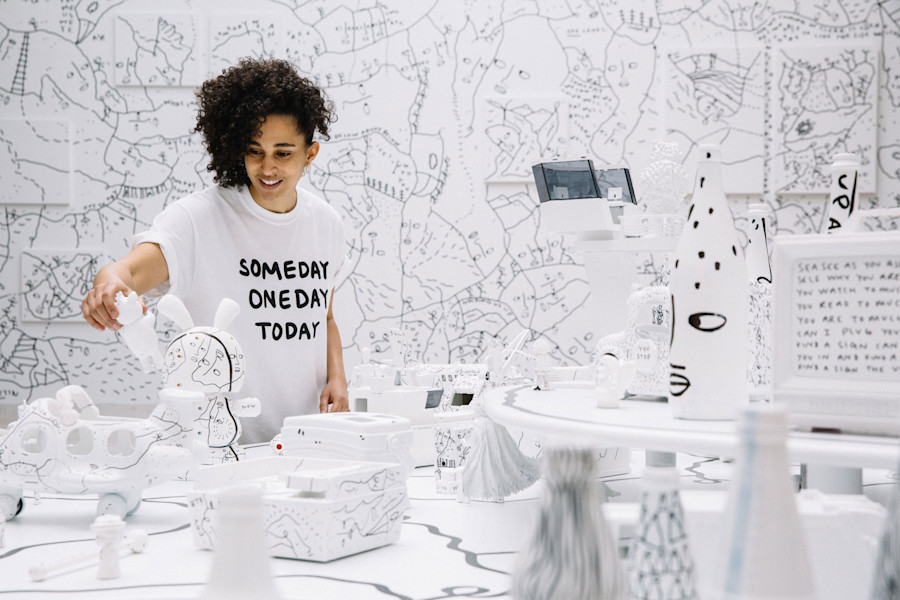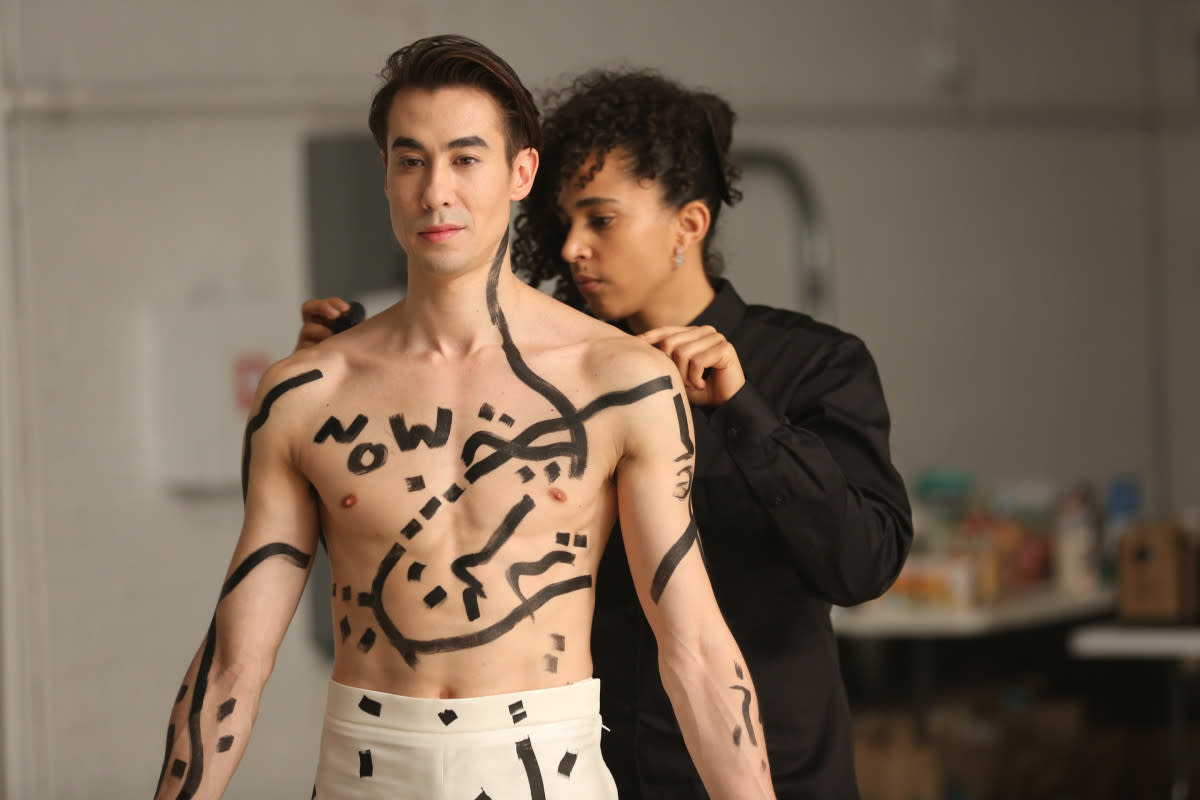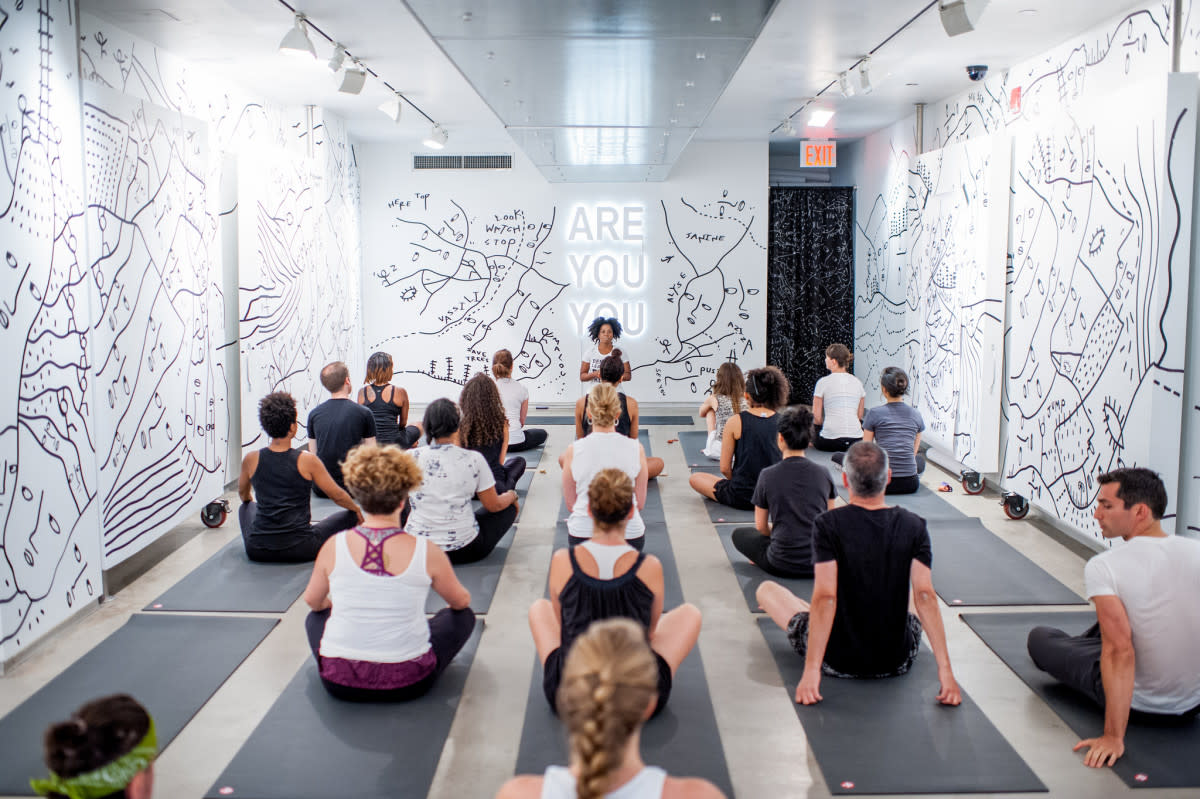Between the lines: a conversation with Shantell Martin

Some artists prefer anonymity; letting their work, and only their work, do the talking. Shantell Martin is not that kind of artist.
Visit Martin’s YouTube channel and you’ll find plenty of evidence of her motivation to “make and share”. She is prolific. Her medium is the pen and the world, or, as she puts it: “I’m drawing on canvases, I’m drawing on walls, I’m drawing on cars, I’m drawing on shirts, I’m drawing on shoes...”

She’s also drawing on the roadside, on people – including New York City Ballet dancers – and on all manner of found objects. Watching Martin create her large (often but not exclusively) black-and-white artworks is to be mesmerised by her unerringly fluid continuous motion, with staccato interruptions as the fat-tipped pen tamps uniform white shirt to get the ink flowing to the nib.
Online, Martin’s life is as equally well shared as her art – perhaps not unsurprisingly, as around 90 percent of her art is made as live performance. While a Cliff’s Notes biography might read, “raised in London’s Thamesmead, attended Central St Martins, had a stint in Japan, eventually established a studio in Jersey City”, the reality, of course, is more complex. In the great tradition of unwarranted assumptions, you could say her life mimics the swooping lines of her art, ups and downs, faces and figures peeking through; or that while her art is linear, her life, like all lives, is not a neat line. To identify one thematic strand from her work, I’d suggest truth to self, because self-awareness and identity seem critical to her practice, guiding her hand when pen becomes an extension of the body. “When you’re drawing life you have no time to think, no time to hesitate, no time to plan, you have no time to be anyone else…As soon as you try to force the pen, you become somebody else.”

Hi Shantell. You’re originally from London, but where do you spend most of your time these days?
I live in Jersey City, New Jersey, which is just across the water from Manhattan. My art studio is at Mana Contemporary and I love living so close to where I work but also it's a bit removed from the city so you can get that space and time away from everything.
Art, performance art, wall, ceiling and clothing as canvas, collaborations, teaching… you don’t seem bound much by convention. What has shaped your view about what you can and can’t do?
I'm very fortunate that I actually left London when I did. I think just getting out and living in different countries and cultures taught me a lot about the world and myself. You realise you can create a positive space for yourself anywhere if you make the choice to just do it. And the more you do it, the more confidence you gain.
Did you like art or artists when you were younger? Did you see things that made you stop and think, ‘hey, I could do something…’?
My earliest introduction to art was actually through cartoons as a child, to be honest. I was more into music as a young adult and followed more musicians which is funny because I'm making more music now that in a way is an extension of my work but through sound.
You also teach a course, ‘Drawing On Everything’, at New York University. What do you try and convey to your students?
The goal of my course is to help my students get more in touch with their individuality through different exercises and experiences and then we take that individuality and distilled voice and apply it to performance. Traditionally, The Museum of Moving Image will host my class finals and it’s always so interesting to see what the students create.
I was interested to read about your dyslexia, and ownership of it as a kind of superpower… how did you take the power back, so to speak?
I have always refused to believe that the things that make me or anyone different is a weakness. The greatest challenges I've experienced, have all fed into my work and make the work what it is and I guess I'm grateful that I've been able to be aware of this.
Just to touch on creativity for a bit, how do you work, what’s your process? I read that you pick up a pen, the mind goes blank, and away you go… Is that right?
It’s definitely a little something like that. Depends on what the project is. There's definitely a bit of preparation that I go through, whether it's research or some kind of meditation that I try to give myself before I make that initial spontaneous mark.
There are of course underlying concerns, thoughts, and themes evident in your work, characters appear and reappear, you incorporate words, ask questions about identity…
It’s interesting because I have always referred to my work as an exploration of a language that has been created to explore extremely personal subjects or themes that somehow have been what has connected my work with so many people. The ability to marry thought and expression into something that is this composed thing is a combination of many, many years of practice and disciplined work in the studio as well as a surrender to art itself. The work is created but in a way it also creates itself. Which in some way might not make sense but...when you're making work, it does feel a bit like that. Like this complete surrender.
Why the pen, specifically? And why black and white?
It's accessible. I haven't always worked in black and white and I've actually been using a bit of colour lately, so who knows where things will go. The most important thing for me has always been using what I have access to and what's readily available. Not just for myself but for others too.
What sort of pens do you use?
I use a lot of Krink pens. You can see what I use here.
You’ve collaborated with Puma, Kendrick Lamar, Tiffany… has one stood out so far?
I can't say that one has been the best, but the work I did with the New York City Ballet was a high point for me. I was able to really connect with a lot of the dancers and explore their work and their practice and the pieces that were created were very much informed by them and their rehearsals – and just learning about and immersing myself in a different craft was really enjoyable.
Performance art in front of an audience means you have to work pretty fast, but what about in the studio, do you take more time?
No, I don't think I take more time but I do feel a pull to do other things in my studio that can be a bit distracting. I find things to organise or people stop by and visit and it can just take time away from my actual drawing but it's also healthy to take that time away and so I do appreciate my studio life and practice too.
How do you think your work has developed over the years, where are you going?
It's become more simple, direct, fluid, honest.
Shantell Martin
Semi Permanent Auckland
15-17 August 2019
Semi Permanent Auckland
15-17 August 2019